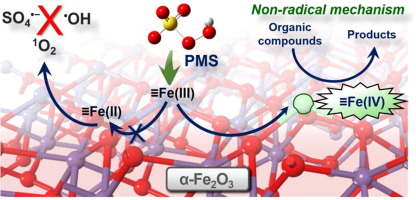Publication
Advanced Redox Technology Lab
Publication
Advanced Redox Technology Lab
Journal papers
Peroxymonosulfate (PMS) activated by Hematite (α-Fe2O3) was capable of degrading different organic compounds. Several lines of experimental evidence are presented which argue against the generation of radical species as well as singlet oxygen (1O2). Tests using radical scavengers and probes, and electron paramagnetic resonance (EPR) spectroscopy suggested that the PMS-activation by α-Fe2O3 does not involve the generation of SO4•−, •OH, and O2•−. The possibility of 1O2 generation was also excluded by EPR spectroscopy and kinetic experiments performed in deuterium oxide. The ternary reactive complex that mediates the electron-transfer between target organic compounds and PMS (frequently proposed as a nonradical mechanism in previous studies) was not likely formed in this system. Based on the electrochemical analyses as well as other experiments, a high-valent iron species (most likely ferryl species, Fe(IV)) is believed to be responsible for the oxidation of organic compounds by the α-Fe2O3/PMS system.
